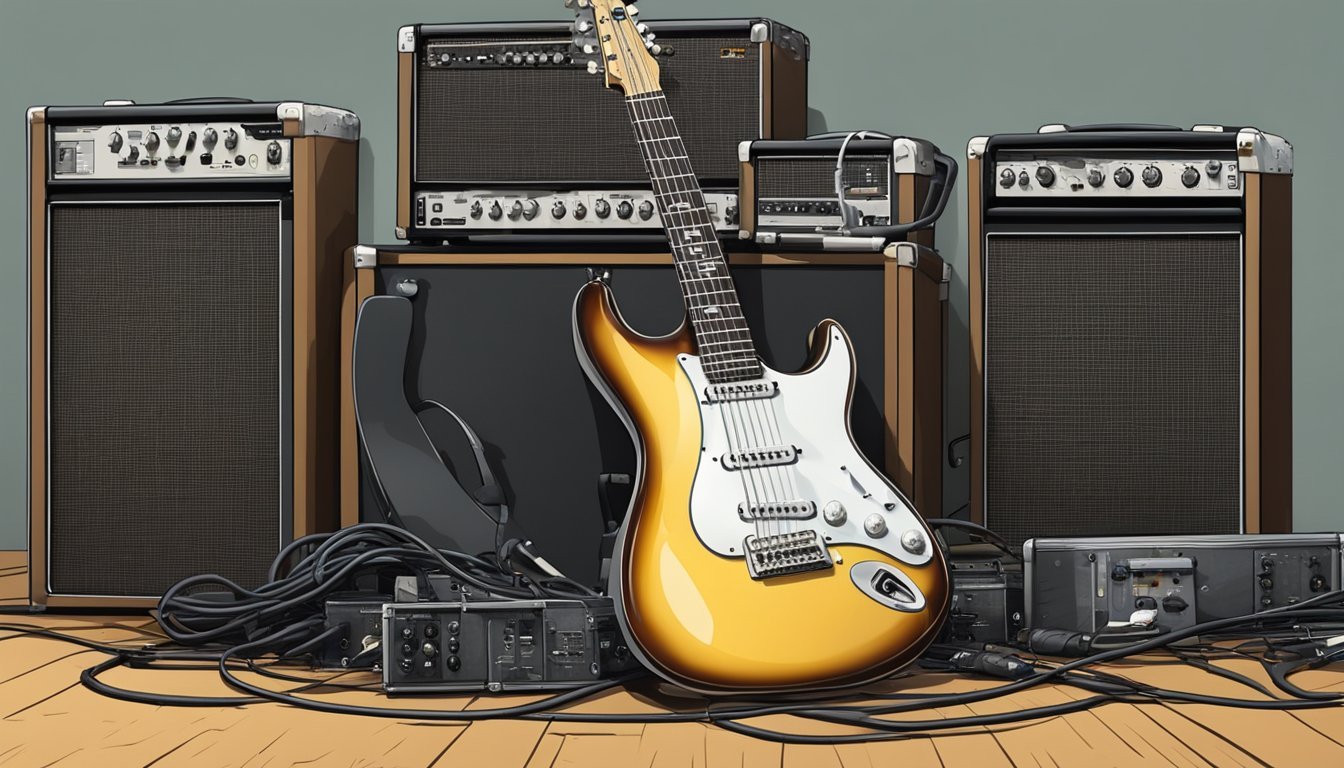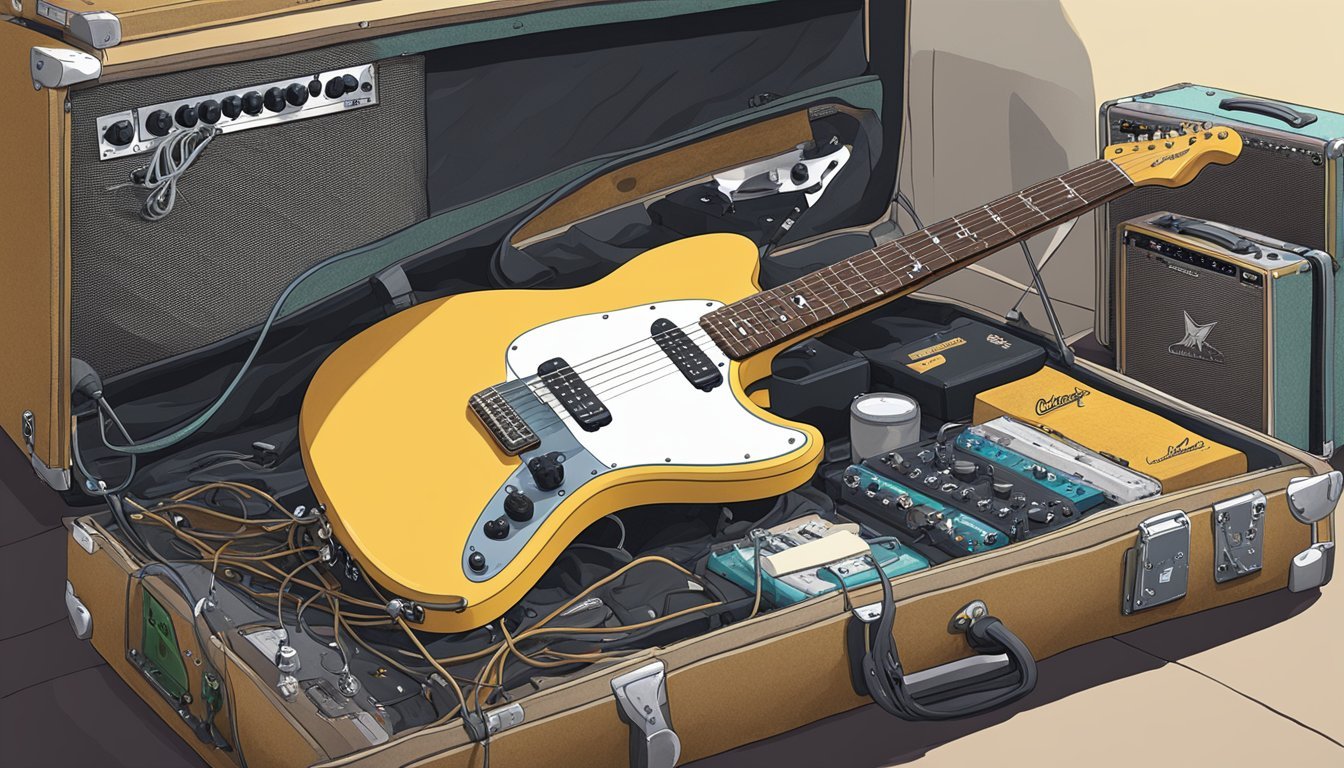Kurt Cobain, the legendary frontman of Nirvana, is well-known for his raw sound and powerful stage presence. He primarily played a Fender Jag-Stang, a unique blend of a Mustang and a Jaguar, which became iconic in the grunge scene. This guitar helped define the music you associate with the 90s and still influences artists today.

Cobain also used a variety of other guitars throughout his career, including modified models from Fender.
His adaptations added a personal touch that contributed to his distinctive sound.
Exploring the instruments he chose reveals a lot about his musical style and creativity.
By examining the guitars Cobain played, you gain insight into the artist’s life and the music that shaped a generation.
Whether you’re a fan or just curious, understanding his gear offers a unique glimpse into rock history.
Key Takeaways
- Kurt Cobain mainly used a Fender Jag-Stang throughout his career.
- He customized his guitars to fit his unique sound and style.
- His choice of instruments continues to inspire musicians today.
Kurt Cobain’s Iconic Guitars
Kurt Cobain had a distinctive style that was shaped by a handful of iconic guitars.
Each instrument played a role in creating his unique sound and image, making them significant in the world of music.
Fender Jaguar and Modifications
The Fender Jaguar was a key part of Kurt’s sound.
He often favored its unique body shape and tone.
Cobain would modify his Jaguars to suit his needs, often switching pickups and adjusting the wirings.
His 1965 Fender Jaguar was known for its vivid finishes.
You can often see him using it in live performances.
Its short scale and easily accessible controls made it perfect for his aggressive playing style.
This guitar contributed to the raw sound that defined Nirvana, allowing Kurt to explore various effects and tones.
The Jaguar’s rich tones and potential for feedback were ideal for his music.
The Fender Mustang Legacy
Another essential guitar in Kurt’s collection was the Fender Mustang.
He used it mainly during the early years of Nirvana.
The Mustang was appealing because it was affordable and versatile, perfect for a left-handed guitarist like Cobain.
Kurt’s modified Mustangs often featured unique paint jobs and swapped pickups.
This customization created a sound that was both edgy and memorable.
While Nirvana’s popularity soared, Cobain’s Mustang was often seen as a symbol of the grunge movement.
Its simple design allowed him to focus on his style rather than complicated mechanics.
Martin Acoustics and MTV Unplugged
When it came to acoustics, the Martin D-18 and D-18E were standout choices for Cobain.
These guitars showcased a different side of his musical talent.
The Martin D-18E, used during the famous MTV Unplugged concert, featured a striking sound and a unique look.
During that performance, his choice of the Martin created an unforgettable atmosphere.
The acoustic guitar’s warm tones complemented his raw vocals perfectly, allowing him to connect deeply with the audience.
It was a vital moment in his career and highlighted the emotional depth of his music.
Kurt’s use of these Martins solidified their place in music history.
Performance and Recordings

Kurt Cobain’s performances and recordings played a huge role in defining his sound and legacy.
His live shows were filled with energy and raw emotion, while his studio sessions captured his unique style and approach to music.
Live Appearances and Notable Events
You might remember Nirvana’s legendary performance of “Smells Like Teen Spirit” on Saturday Night Live in 1992.
This iconic moment showcased Cobain’s intense energy and the raw power of his guitar.
During the In Utero tour, Cobain often used heavy feedback and distortion in his set to enhance the band’s sound.
The Live at the Paramount concert is another highlight, where the energy of the crowd mixed perfectly with tracks like “Lithium” and “In Bloom.” These shows demonstrated how Cobain connected deeply with fans through his passionate performances.
Studio Sessions and Signature Sound
In the studio, Cobain was known for his creative recording techniques.
For the album Nevermind, he recorded with producer Butch Vig, who helped shape the band’s signature sound.
Cobain pushed boundaries by using unconventional methods, like plugging his guitar directly into the mixing board for tracks like “Territorial Pissings.”
On In Utero, he aimed for a more raw and abrasive sound, reflecting his artistic vision.
Songs like “Heart-Shaped Box” feature heavy distortion, showcasing his desire to break away from mainstream expectations.
This commitment to authenticity helped solidify his impact in the music industry.
Guitars After Kurt
Kurt Cobain’s guitars have become legendary, both in music and in the auction world.
After his passing, they shaped the landscape of grunge and punk rock while also attracting collectors and fans alike.
Auction History and Collectors
Kurt’s most famous guitar, the Martin D-18E, made headlines when it sold for a staggering $6 million at Julien’s Auctions.
This sale marked it as the most expensive guitar ever auctioned.
Peter Freedman, a prominent collector, emphasized its significance as a cultural artifact representing the grunge era.
Many guitars owned by Kurt have entered auctions, drawing interest from both collectors and fans.
Each transaction usually stirs discussion about their history and value, often linking back to Cobain’s impact on music.
Legacy and Influence on Music
Kurt’s choice of guitars significantly influenced the sound of the Seattle grunge scene.
He played various iconic guitars, including the Fender Jaguar and the Jag-Stang, each contributing to his unique sound.
His style inspired many musicians, especially in the punk and alternative rock genres.
Even today, guitarists seek to replicate Cobain’s tone, cementing his legacy in the music industry.
His instruments became symbols of rebellion, capturing the essence of the era he represented.
Through auctions and musical influence, Cobain’s guitars continue to resonate with fans and artists alike.
Frequently Asked Questions

You might have some questions about Kurt Cobain’s guitar choices and their significance.
From the guitars he played during memorable performances to the story behind his first instrument, there’s a lot to explore.
Cobain’s iconic Fender Mustang and the distinctive sounds he achieved with them are synonymous with the grunge movement of the early ’90s.
His artistic expression extended beyond music, as he often experimented with how to paint your guitar, adding personal touches that reflected his individuality.
Understanding these choices offers a deeper insight into his creative process and the lasting impact of his artistry on both music and culture.
What kind of guitar did Kurt Cobain strum on the MTV Unplugged session?
During the MTV Unplugged session, Kurt played a Martin D-18E acoustic guitar.
This guitar was special for its unique sound and played a big role in the raw, emotional performance that day.
Can you tell me about Kurt Cobain’s go-to guitar during the ‘Bleach’ era?
In the ‘Bleach’ era, Kurt favored a Fender Mustang.
This guitar matched his grunge style and was known for its distinct tone, which helped shape the band’s early sound.
Which Fender model was a fave of Kurt Cobain?
Kurt Cobain had a soft spot for the Fender Jag-Stang.
This model was a blend of the Fender Mustang and Jaguar, and it became closely associated with his signature sound throughout the ’90s.
What’s the backstory of Kurt Cobain’s first ever guitar?
Kurt’s first guitar was a used Fender Mustang he got as a teenager.
It played a crucial role in his development as a musician and helped him shape his early songwriting.
Ever wonder about the guitar Kurt Cobain smashed on stage?
Kurt famously smashed several guitars during live shows, but one memorable moment was when he destroyed a Fender Stratocaster.
This act became a symbol of the raw energy and rebellion of the grunge era.
What guitar was behind the iconic sounds of Kurt Cobain on ‘Nevermind’?
On ‘Nevermind’, Kurt primarily used a Fender Jaguar and a modified Fender Stratocaster.
These guitars contributed to the album’s iconic sound and solidified his role as a leading voice in rock music.

